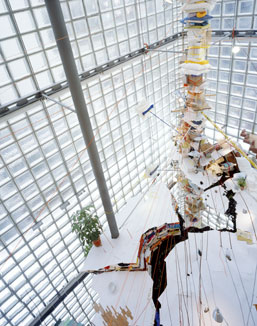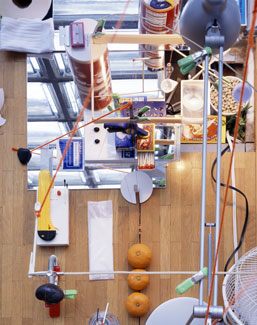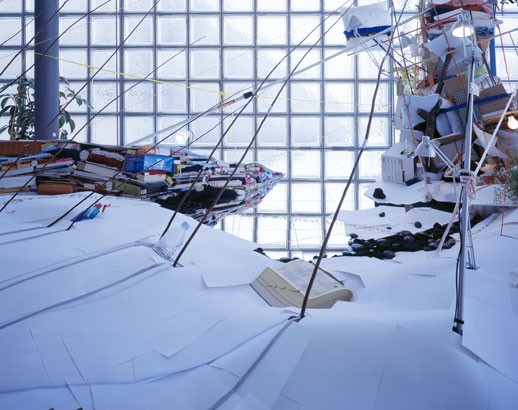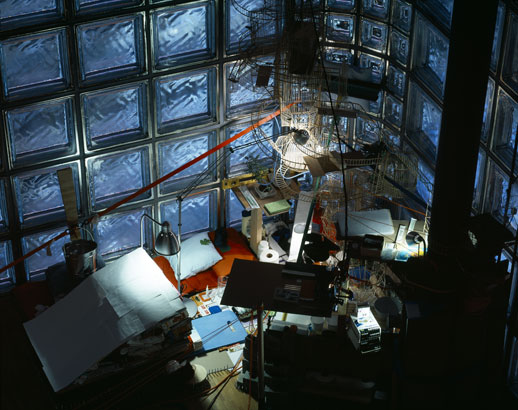“To see a World in a grain of sand”
In a city that sometimes seems premised on a culture of accessory, Sarah Sze’s lyrical installation at Hermès, a great example of her work, is a welcome detour from the Ginza shopfronts.
Sze’s exhibition is quite an exciting addition to the line-up at Maison Hermès, one of a handful of gallery spaces run by fashion and cosmetic companies in the Ginza area. Although they have previously shown large installations by artists such Do-Ho Suh, which engage with the entire exhibition area, Sze’s intervention is a more extreme unsettling of the gallery’s bounds, both spatially and conceptually.
Sze’s installations are not only a meticulous choreography of ‘stuff’, but also draw directly on her studies in sculpture. Walking into the space, the eye and body are led here and there by lines of thread and rope spanning the gallery, prompting one to turn corners or walk into closet spaces, all the time surrounded by leaves, beans, copious sheets of paper, boxes and stationery. At first it seems as though your entire office just walked in and emptied its contents into the gallery. Objects such as fire extinguishers have even been cut and arranged to appear as though they are emerging from, or sinking into, the walls and floor.


The dynamic visual repetition, and overall sense of direction created in the work is focused on the main gallery’s far corner. This elegantly controls the ‘zero gravity’ of the myriad objects, pulling them into orbit around that single nodal point. Sze extends this structure all the way into the smaller interior space, emphasizing the notion that some greater physics of her design have taken control of the gallery, no longer contained by the four walls of the exhibition areas. The background to this nodal point is a translucent, glass-brick wall, allowing the character of these myriad orbiting objects to change with the natural and artificial light outside, further suggesting that the work in fact extends beyond the gallery’s physical limits.

Initial impressions of pure chaos are overcome as one becomes accustomed to the particular physics in Sze’s work. It becomes clearer that these objects maintain a potent, yet calm suspension: things are often literally left dangling, or in suggestively precarious arrangements. At one point I imagined the work as a giant, cocked mousetrap. Suspense here is not inert, nor merely imminent, but rather full of uncanny potential (future-time), while simultaneously drawing on our memories of and associations with these familiar objects (time-past). As such, I think it is impossible to discuss Sze’s work simply in physical, spatial terms. No amount of detailed description could hope to convey the hidden corners or the creative repetitions of material and form, the odd combinations of objects (suggestive of Surrealist strategies?), and the complex assembly of miniature installations within the larger one—this work is an ongoing micro/macro, playful tug-o-war.

It seems more satisfying to consider this work in terms of ‘choreography’, or composition—in the sense of music, theatre or film; that is, as time-based media. Sze’s lyrical use of objects in motion (such as suspended papers fluttering in an electric fan’s breeze) and sophisticated visual suggestions made by montaging objects that contrast each other’s characteristics (for example, a candle in a vice, or her use of springs and elastic bands) consistently engages with time as a material element. The complex language of musical notation, developed to describe and direct a temporal art in static visual terms, seems to offer rich descriptive potential for such installations. Hence, as with a fugue, intermezzo, cadenza or rondo, Sze’s work includes different compositional elements. Then again, different ‘passages’ in this installation can be described as minor rhythms or motifs, such as accelerando, glissando or crescendo. I was left thinking about the attempts of early twentieth century artists to visualize sound and time, such as Kandinsky’s expressionist works for example, but also Eisenstein’s well-known ‘spatio-temporal schemas’.
Galleries run by fashion houses can sometimes seem a bit small or stuffy, giving the impression of showing only safe, generally well-known artists, or work that somehow reflects well on the ‘culture’ of the company. While this can at times make for an exhibit of interesting artworks, it does not necessarily become an interesting exhibition overall. What Sze has been allowed to realize here—and surely part of her art is in negotiating these logistics—is a reminder that despite their corporate nature being in many ways antithetical to many artist’s ideas, these exhibition spaces do have the potential to put on truly stimulating exhibitions.
—
The title of this review is taken from ‘Auguries of Innocence’ by William Blake, in Nicholson & Lee, eds. The Oxford Book of English Mystical Verse, 1917
Olivier Krischer
Olivier Krischer


